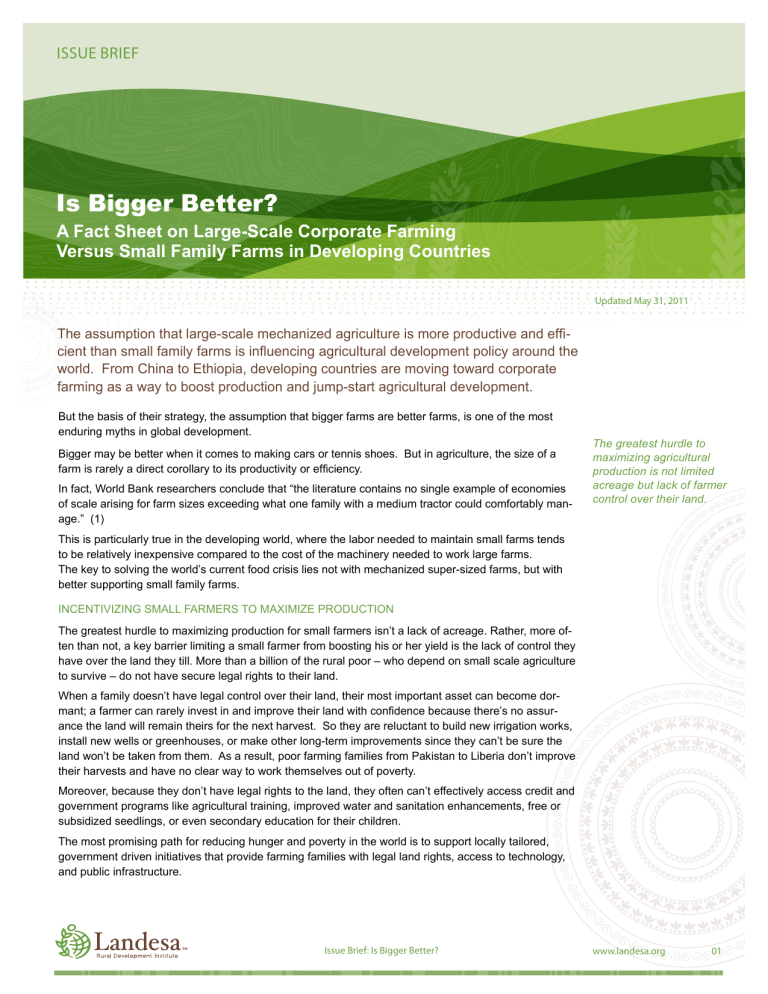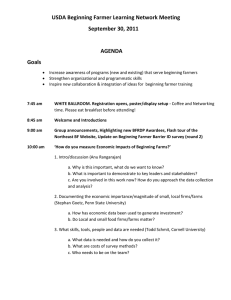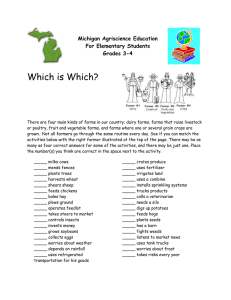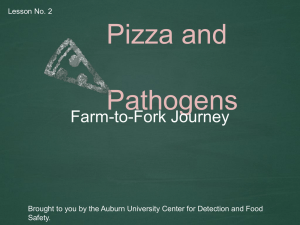Is Bigger Better?

Issue BrIef
Is Bigger Better?
A Fact Sheet on Large-Scale Corporate Farming
Versus Small Family Farms in Developing Countries
updated May 31, 2011
The assumption that large-scale mechanized agriculture is more productive and effi cient than small family farms is influencing agricultural development policy around the world. From China to Ethiopia, developing countries are moving toward corporate farming as a way to boost production and jump-start agricultural development.
But the basis of their strategy, the assumption that bigger farms are better farms, is one of the most enduring myths in global development.
Bigger may be better when it comes to making cars or tennis shoes. But in agriculture, the size of a farm is rarely a direct corollary to its productivity or efficiency.
In fact, World Bank researchers conclude that “the literature contains no single example of economies of scale arising for farm sizes exceeding what one family with a medium tractor could comfortably manage.” (1)
This is particularly true in the developing world, where the labor needed to maintain small farms tends to be relatively inexpensive compared to the cost of the machinery needed to work large farms.
The key to solving the world’s current food crisis lies not with mechanized super-sized farms, but with better supporting small family farms.
INCENTIVIZING SMALL FARMERS TO MAXIMIZE PRODUCTION
The greatest hurdle to maximizing production for small farmers isn’t a lack of acreage. Rather, more often than not, a key barrier limiting a small farmer from boosting his or her yield is the lack of control they have over the land they till. More than a billion of the rural poor – who depend on small scale agriculture to survive – do not have secure legal rights to their land.
When a family doesn’t have legal control over their land, their most important asset can become dormant; a farmer can rarely invest in and improve their land with confidence because there’s no assur ance the land will remain theirs for the next harvest. So they are reluctant to build new irrigation works, install new wells or greenhouses, or make other long-term improvements since they can’t be sure the land won’t be taken from them. As a result, poor farming families from Pakistan to Liberia don’t improve their harvests and have no clear way to work themselves out of poverty.
Moreover, because they don’t have legal rights to the land, they often can’t effectively access credit and government programs like agricultural training, improved water and sanitation enhancements, free or subsidized seedlings, or even secondary education for their children.
The most promising path for reducing hunger and poverty in the world is to support locally tailored, government driven initiatives that provide farming families with legal land rights, access to technology, and public infrastructure.
The greatest hurdle to maximizing agricultural production is not limited acreage but lack of farmer control over their land.
Issue Brief: Is Bigger Better?
www.landesa.org
01
updated May 31, 2011
WHAT THE RESEARCH SHOWS
• While yields on family farms are sometimes lower than those on large farms, family farm costs are often lower than large farms. For example, a study of major rice exporters that found that small
Vietnamese farms had half the yield per acre, but produced each ton of rice at half the cost as large farms in Uruguay. (2)
• Smallholder cultivation is also more equitable. Small farmer income is two times to ten times higher than the income from wage employment. (3)
• The export growth witnessed in Vietnam, Thailand and Peru following clarification of the property rights system illustrates the production boost prompted by secure property rights alone. (4)
• Economies of scale do exist for processing and marketing. And vertical integration of large planta tions with large-scale central processing units makes sense when the crop is best processed within a short time after harvest, as is the case for palm oil, sisal, and certain tea varieties. (5)
• Large farmers tend to plant only one crop (monoculture production) because that is simplest to manage with heavy machinery. Small farmers, especially in the third world, are more like to intersperse crops and diversify their risk. Monoculture usually requires more pesticide use or higher labor costs. (6)
• Broadening land access sparks sustainable economic development. A 21-country analysis showed that a decrease in land concentration by one-third leads to a one-half reduction of the poverty level within 12 to 14 years. (7)
SOURCES
(1) Binswanger & Deininger, South African Land Policy: The Legacy of History and Current Options, in J. van Zyl, J. Kirsten & H.P. Binswanger, eds., Agricultural Land Reform in South Africa: Policies,
Markets and Mechanisms 64 (Oxford University), 1993
(2) Insituto Nacional de Investigacion Agropecuaria Uruguay, 2007
(3) Klaus Deininger and Derek Byerlee, Rising Global Interest in Farmland, World Bank, 2011
(4) Klaus Deininger and Derek Byerlee, Rising Global Interest in Farmland, World Bank, 2011
(5) Roy Prosterman, Robert Mitchell, Tim Hanstad, One Billion Rising, Leiden University Press, 2009
(6) The United States Department of Agriculture’s (USDA) National Commission on Small Farms, “A
Time to Act.”, 1998
(7) M. R. El Ghonemy, G. Tyler & Y. Couvreur, Alleviating Rural Poverty Through Agricultural Growth,
29 Journal of Development Studies, 358-364, 1993 four DecaDes. 40 countrIes.
400 MIllIon people.
founded as the rural Development Institute (rDI), landesa’s work in more than 40 developing countries over that past four decades has improved individual lives, families, and communities.
More than 100 million families worldwide — representing well over 400 million people — have received land rights as a result of our partnerships with governments and other development organizations.
Securing land rights for the world’s poorest
this transformation—from land insecurity or landlessness to secure rights to land—has boosted agricultural productivity in the developing world by billions of dollars per year, improved health, nutrition and school enrollment in hundreds of villages across the globe, and placed scores of billions of dollars in new land wealth in the hands of the rural poor.
Small farmer income is two times to ten times higher than the income from wage employment.
Issue Brief: Is Bigger Better?
www.landesa.org
02




